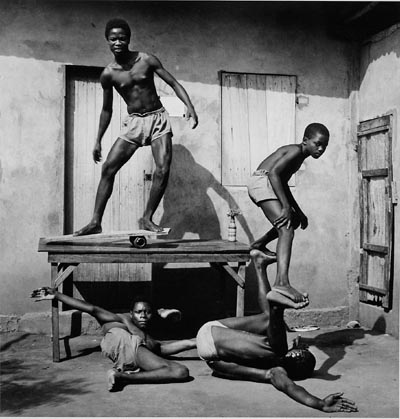 Christophe Mahoukpé: Studio Photo Classique, Dekamney Silbergelatine-Abzug, 44,3 x 42,5 cm © Alex Van Gelder Leben und Tod in Bénin Afrikanische Fotografen aus der Sammlung Alex Van Gelder Click for English text Im rund einhundertfünfzig Kilometer breiten Küstenstreifen des Golf von Bénin, von Togo über Bénin bis hin nach Lagos in Nigeria, entwickelt sich heute ein dicht besiedelter und ungeplant wachsender Wirtschaftsraum, den der niederländische Architekt und Städteplaner Rem Koolhaas bereits als visionäres neues Metropolis preist. Schon in der Mitte des vergangenen Jahrhunderts, erlebten Bénin und die Nachbarländer einen ersten explosionsartigen Innovationsschub. Entlang der Elfenbeinküste, auf dem Seeweg von Europa nach Indien, kam es in den Hafenstädten Bénins (Porto-Novo, Cotonou oder Odinah) schon vor der vollständigen Unabhängigkeit 1960 im Zuge wachsender Handelsbewegungen zu ersten Berührungen mit Kommunikationsmitteln der Moderne. Eines davon war die Fotografie, die zeitgleich mit diesem gesellschaftlichen Aufbruch einen Platz im öffentlichen Bewusstsein Afrikas fand und diesen Schub gleichsam verkörperte. Waren es zuerst vor allem die französischen Kolonialherren, die die Fotografie, die sie schon zu Beginn des Jahrhunderts ins Land gebracht hatten, genutzt haben, so übernahmen nach der politischen Unabhängigkeit recht schnell die bis dahin im Lande ausgebildeten Fotografen die verlassenen Studios oder gründeten selbst ihre eigenen. Und diese Fotografen porträtierten die Kinder, die erste Kommunion, die Hochzeit und das eine zentrale Porträt - und sie fotografierten das Totenbett, die Vereinigung der Verwandten in letzten Zeremonien, Ritualen am Bett des Toten. Wanderfotografen waren sie einerseits und porträtierten die Menschen vor ihrem eigenen Haus, Studiofotografen waren sie andererseits in den Städten und stellten die Menschen vor ihre selbstgemalten Hintergründe, vor gemalte Flugzeuge und Wohnungseinrichtungen hin. Alle Fotografen, deren Werke in der Sammlung Alex Van Gelder vereint sind, haben in den 1960er bis zu den 1980er Jahren in Bénin gearbeitet, darunter die in der Ausstellung vertretenen Benoît Adjovi, Jean Agbétagbo, Joseph Moïse Agbodjélou, Bouraïma Akodji, Léon Ayékoni, Christophe Mahoukpé, Sébastien Méhinto genannt Pigeon, Edouard Méhomé und Camille Tchawlassou. Für viele der Porträtierten war der Augenblick des Fotografiertwerdens unvergesslich, denn erstens war es oft das allereinzige Mal, dass sie sich ein Porträt überhaupt leisten konnten und zweitens war es das Porträt, das in den letzten Zeremonien hinter, neben oder auf das Totenbett gestellt wurde, weil darin die Seele des Verstorbenen wieder aufscheinen sollte. Diese besonders intensiven, aussergewöhnlichen Porträts zeigen anhand von Menschenbildern Bénin im Wandel zur postkolonialen Zeit. Kurator: Urs Stahel Zur Ausstellung erscheint ein Buch im Phaidon Verlag, London. Hauptsponsor: Pick Pay Mit Unterstützung der Direktion für Entwicklung und Zusammenarbeit DEZA. Ausstellungsdauer: 4.6. - 21.8.2005 Oeffnungszeiten: Di-So 11 - 18 Uhr, Mi 11 - 20 Uhr Montag geschlossen Fotomuseum Winterthur Halle und Galerie Grüzenstrasse 44 + 45 8400 Winterthur Telefon +41 (0)52 234 10 60 Fax +41 (0)52 233 60 97 Email fotomuseum@fotomuseum.ch www.fotomuseum.ch Life and Death in Bénin African Photographers from the Alex Van Gelder Collection In the one hundred and fifty kilometre-wide coastal strip of the Gulf of Bénin stretching from Togo via Bénin to Lagos in Nigeria, a densely populated and arbitrarily growing economic area is currently developing, which the Dutch architect and urban planner Rem Koolhaas is already extolling as a visionary new metropolis. In the middle of the last century, Bénin and its neighbouring countries were already experiencing the first explosive innovative impetus. Along the Ivory Coast, on the sea route from Europe to India, first contacts with modern means of communication were made in Bénin's ports (Porto-Novo, Cotonou and Odinah) following growing trade movements before complete independence was gained in 1960. One of these modern means of communication was photography, which found its place in the African public consciousness and as it were embodied this impetus at the same time as the new social departure. Whereas it was above all the French colonial lords who used photography, which they had introduced into the country at the beginning of the century after political independence had been gained, the photographers who had hitherto been trained in the country took over the abandoned studios and founded some of their own. And these photographers made portraits of children, of First Communions, of weddings and the one central portrait; and they photographed deathbeds, the union of the relatives in the final ceremony, and the ritual at the bedside of the dead person. They were itinerant photographers who took portraits of people in front of their own homes, they were studio photographers in the towns who placed people in front of their self-painted backgrounds, in front of aeroplanes and household furnishings. All the photographers whose work is contained in the collection of Alex van Gelder worked in Bénin between the 1960s and the 1980s, among them the photographers represented in the exhibition: Benoît Adjovi, Jean Agbétagbo, Joseph Moïse Agbodjélou, Bouraïma Akodji, Léon Ayékoni, Christophe Mahoukpé, Sébastien Méhinto (known as Pigeon), Edouard Méhomé and Camille Tchawlassou. And for many of the people portrayed, the moment of being photographed remained unforgettable because, firstly, it was usually the only time that they could ever afford a portrait and secondly, it was the portrait that would be placed on or beside their deathbed at the final ceremony, because the soul of the deceased appeared to emanate from it once again. These particularly intensive portraits show different people and tribes in Bénin during the transition to the postcolonial era. Curator: Urs Stahel A book of the exhibition will be published by Phaidon Publishers, London. Main sponsor: Pick Pay With the support of the Swiss Agency for Development and Co-operation SDC. Exhibition: 4 June - 21 August 2005 Opening hours: Tues-Sun 11 am - 6 pm, Wed 11 am - 8 pm Closed on Mondays |